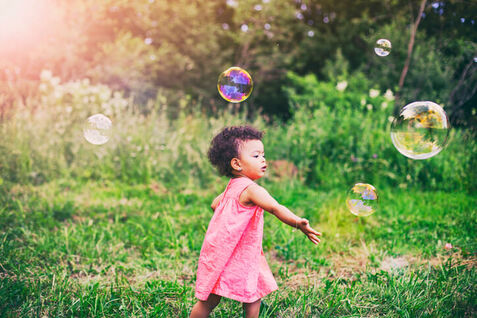 With summer winding down, it's more crucial now than ever to get our kids outside enjoying the weather! While playing outside, how do you keep expanding on the language development your little ones are starting to show? While you are playing outside, you can still talk, tempt, and repeat! Check out this list below for ideas on how to implement these strategies while playing outside. SAND BOXES & GARDENS: use verbs like dig, pour, build, dump, stack, press, smush, spread, grow, etc. Use adjectives like rough, smooth, bumpy, big, small, short, tall, etc. Use location words like in, out, on, off, under, over, up, down, etc. Use action and descriptive language to expand on your child’s words. Remember to think about color, size, shape, and other attributes of the sand, plants, dirt, and toys you are using. Keep shovels, buckets, molds, and other toys in multiple small clear containers with tops your child has a hard time opening independently. That way they have to request objects. When they request an object (e.g., shovel) present them with multiple options (e.g., “blue shovel or green shovel?” or “small shovel or big shovel?”). Make silly mistakes while playing. When filling up a bucket, accidentally miss the bucket. Build a castle and put the big bucket on top. Try to put a flower on your head instead of planting it on the ground. Hold your shovel the wrong way. These are all fun and engaging ways for your child to correct you creating a communication opportunity. POOLS & WATER: use verbs like splash, pour, dump, push, float, sink, spray, spill, bubble, wash, rain, etc. Use adjectives like wet, dry, bubbly, flat, hot, cold, icy, warm, clear, murky, etc. Use location words like in, out, on, off, under, over, up, down, etc. Remember to think about color, size, shape, and other attributes of the sand and toys you are using. Keep bowls, buckets, water toys, floaties, diving toys, and other toys in multiple small clear containers with tops your child has a hard time opening independently. Throw toys into the deep end or sink toys to the bottom and have your child request that you go get them. Freeze small toys in ice cube trays and see if they sink or float. Let your child decide if they want you to make big drops or little drops. Give your child choices and use silly play. Hold a bucket upside down and try to fill it up. Try to squirt water out of a toy without any water inside. BIKES, TRIKES, & SCOOTERS: use verbs like push, scoot, pedal, steer, balance, speed, turn, sit, stand, stop, go, etc. Use adjectives like fast, slow, round, squeaky, bumpy, smooth, straight, curvy, long, short, etc. Use location words like on, off, up, down, around, under, over, etc. Remember to think about color, size, shape, and other attributes of your bikes, trikes, and scooters. Can you store the bikes, trikes, and scooters somewhere out of your child’s reach? Do you often take a specific route while riding? Try going a different way, or the wrong way, on your ride and see what your child says. While riding, comment on the variety of things you see around you. Talk about how you want to ride. Do they want to go fast or slow? Do they want to be pushed forward or backward? Are you riding in a line? Talk about who’s first, next, or last. CHALK: use verbs like draw, drag, circle, color, write, rub, etc. Use adjectives like big, small, hard, soft, short, long, dry, wet, etc. Use locations words like over, under, on top, below, next to, between, etc. Don’t forget to talk about color, size, shape, and other attributes. Remember to encourage requesting by keeping the chalk, and other chalk related toys, in smaller containers or out of reach places. Draw things your child is interested in to maintain their attention. Draw characters your child likes, but intentionally make mistakes. When presenting items to your child, make sure to give options and choices. Hold options up in order to present them verbally and visually.
0 Comments
|
A2 Therapy WorksMonthly tips, tricks, and activity ideas from our therapists! Archives
March 2022
Categories |

 RSS Feed
RSS Feed